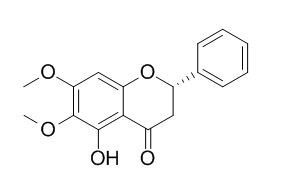Onysilin
Onysilin has anti-atherosclerotic activity.
Inquire / Order:
manager@chemfaces.com
Technical Inquiries:
service@chemfaces.com
Tel:
+86-27-84237783
Fax:
+86-27-84254680
Address:
1 Building, No. 83, CheCheng Rd., Wuhan Economic and Technological Development Zone, Wuhan, Hubei 430056, PRC
Providing storage is as stated on the product vial and the vial is kept tightly sealed, the product can be stored for up to
24 months(2-8C).
Wherever possible, you should prepare and use solutions on the same day. However, if you need to make up stock solutions in advance, we recommend that you store the solution as aliquots in tightly sealed vials at -20C. Generally, these will be useable for up to two weeks. Before use, and prior to opening the vial we recommend that you allow your product to equilibrate to room temperature for at least 1 hour.
Need more advice on solubility, usage and handling? Please email to: service@chemfaces.com
The packaging of the product may have turned upside down during transportation, resulting in the natural compounds adhering to the neck or cap of the vial. take the vial out of its packaging and gently shake to let the compounds fall to the bottom of the vial. for liquid products, centrifuge at 200-500 RPM to gather the liquid at the bottom of the vial. try to avoid loss or contamination during handling.
Molecules.2024, 29(17):4034.
Molecules.2023, 28(13):4972.
Molecules2022, 27(12):3824.
Applied Biological Chemistry2024, 67:66.
Planta Med.2022, a-1876-3009.
Molecules.2022, 27(2):451.
Molecular Simulation2023, 49(8):799-815.
Food Chem.2017, 228:301-314
Agriculture2022, 12(2),227.
Heliyon.2023, 9(6):e16138.
Related and Featured Products
Phytomedicine. 2014 Oct 15;21(12):1651-7.
Cytotoxicity and modes of action of 4'-hydroxy-2',6'-dimethoxychalcone and other flavonoids toward drug-sensitive and multidrug-resistant cancer cell lines.[Pubmed:
25442273]
Resistance of cancer to chemotherapy is a main cause in treatment failure. Naturally occurring chalcones possess a wide range of biological activities including anti-cancer effects. In this work, we evaluated the antiproliferative activity of three chalcones [4'-hydroxy-2',6'-dimethoxychalcone (1), cardamomin (2), 2',4'-dihydroxy-3',6'-dimethoxychalcone (3)], and four flavanones [(S)-(-)-pinostrobin (4), (S)-(-)-Onysilin (5) and alpinetin (6)] toward nine cancer cell lines amongst which were multidrug resistant (MDR) types.
METHODS AND RESULTS:
The resazurin reduction assay was used to detect the antiproliferative activity of the studied samples whilst flow cytometry for the mechanistic studies of the most active molecule (1).
IC50 values in a range of 2.54 μM against CEM/ADR5000 leukemia cells to 58.63 μM toward hepatocarcinoma HepG2 cells were obtained with 1. The lowest IC50 values of 8.59 μM for 2 and 10.67 μM for 3 were found against CCRF-CEM cells leukemia cells, whilst the corresponding values were above 80 μM for 4 and 6. P-glycoprotein-expressing and multidrug-resistant CEM/ADR5000 cells were much more sensitive toward compound 1 than toward doxorubicin and low cross-resistance or even collateral sensitivity was observed in other drug-resistent cell lines to this compound. Normal liver AML12 cells were more resistant to the studied compounds than HepG2 liver cancer cells, indicating tumor specificity at least to some extent. Compound 1 arrested the cell cycle between Go/G1 phase, strongly induced apoptosis via disrupted mitochondrial membrane potential (MMP) and increased production of reactive oxygen species (ROS) in the studied leukemia cell line.
CONCLUSIONS:
Chalcone 1 was the best tested cytotoxic molecule and further studies will be performed in order to envisage its possible use in the fight against multifactorial resistant cancer cells.
Chin Med. 2010 May 13;5:17.
Isolation and identification of bioactive compounds in Andrographis paniculata (Chuanxinlian).[Pubmed:
20465823]
Andrographis paniculata (Burm. f.) Nees (Acanthaceae) is a medicinal plant used in many countries. Its major constituents are diterpenoids, flavonoids and polyphenols.
METHODS AND RESULTS:
Among the single compounds extracted from A. paniculata, andrographolide is the major one in terms of bioactive properties and abundance. Among the andrographolide analogues, 14-deoxy-11,12-didehydroandrographolide is immunostimulatory, anti-infective and anti-atherosclerotic; neoandrographolide is anti-inflammatory, anti-infective and anti-hepatotoxic; 14-deoxyandrographolide is immunomodulatory and anti-atherosclerotic. Among the less abundant compounds from A. paniculata, andrograpanin is both anti-inflammatory and anti-infective; 14-deoxy-14,15-dehydroandrographolide is anti-inflammatory; isoandrographolide, 3,19-isopropylideneandrographolide and 14-acetylandrographolide are tumor suppressive; arabinogalactan proteins are anti-hepatotoxic.
CONCLUSIONS:
The four flavonoids from A. paniculata, namely 7-O-methylwogonin, apigenin, Onysilin and 3,4-dicaffeoylquinic acid are anti-atherosclerotic.



